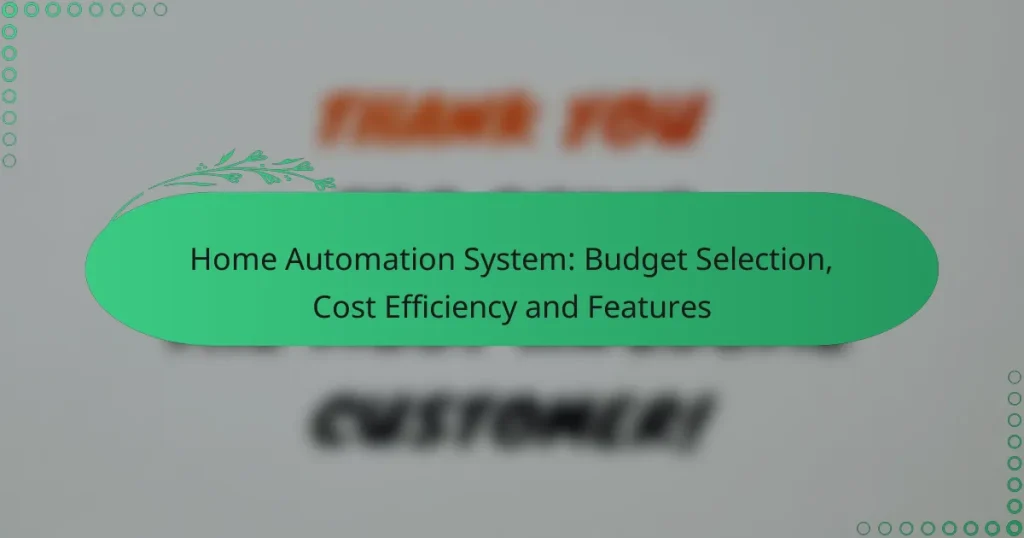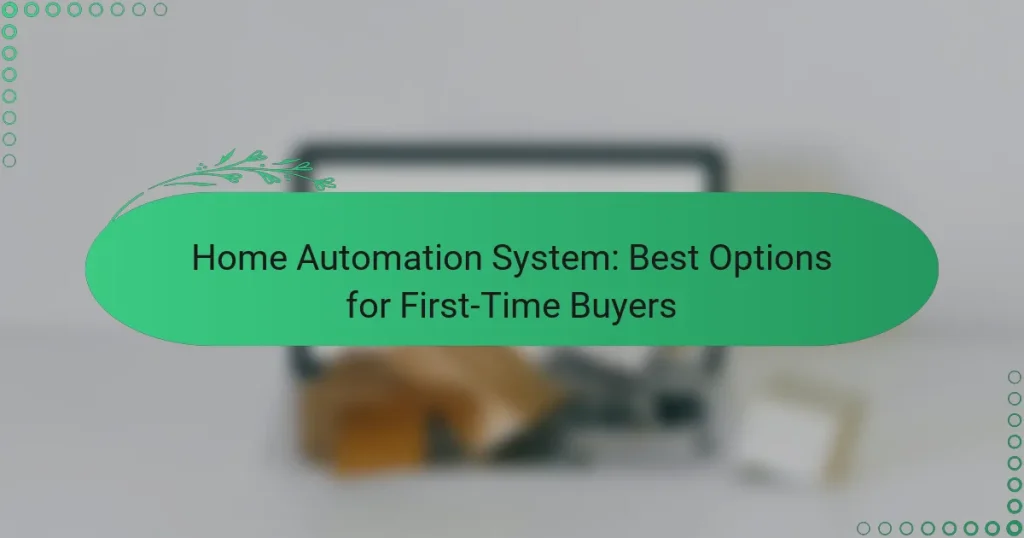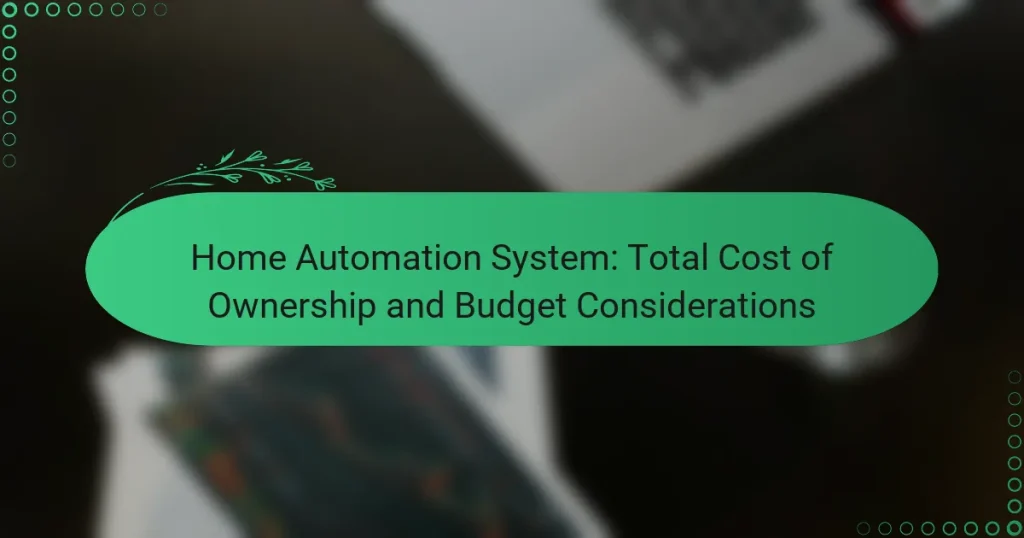Home automation systems offer homeowners in the US a valuable opportunity to reduce costs by optimizing energy usage and improving overall efficiency. By integrating smart technologies, these systems can lead to lower utility bills and prolong the lifespan of household appliances, making them a worthwhile investment for many. While initial costs can vary, the long-term savings and enhanced convenience often provide a strong return on investment.
Home Automation System: Best Options for First-Time Buyers
Home Automation System: Total Cost of Ownership and Budget Considerations
How can home automation systems save costs in the US?
Home automation systems can significantly reduce costs for homeowners in the US by optimizing energy use and enhancing efficiency. By integrating smart technologies, households can lower utility bills and extend the lifespan of appliances.
Energy savings through smart thermostats
Smart thermostats adjust heating and cooling based on your schedule and preferences, leading to substantial energy savings. By learning your habits, these devices can reduce heating and cooling when you’re not home, often saving 10-15% on energy bills.
Consider models that allow remote access via smartphone apps, enabling you to adjust settings on the go. Look for features like geofencing, which automatically adjusts temperatures based on your location.
Reduced utility bills with automated lighting
Automated lighting systems can significantly decrease electricity usage by ensuring lights are only on when needed. Motion sensors and timers help eliminate wasted energy, potentially reducing lighting costs by 20-30%.
Invest in LED bulbs paired with smart switches or hubs that allow for remote control and scheduling. This setup not only cuts costs but also enhances convenience and security by simulating occupancy when you’re away.
Long-term savings from smart appliances
Smart appliances, such as refrigerators, washers, and dryers, are designed to operate more efficiently than their traditional counterparts. Many models provide energy usage reports, helping you identify savings opportunities and adjust usage patterns accordingly.
When selecting smart appliances, look for ENERGY STAR ratings, which indicate higher efficiency. Although the initial investment may be higher, the long-term savings on energy bills can offset the cost over time, often resulting in a payback period of a few years.
What are the initial costs of home automation systems?
The initial costs of home automation systems can vary widely based on the complexity and scale of the setup. Basic systems may start in the low hundreds of dollars, while more advanced configurations can reach several thousand dollars.
Average installation costs for smart home systems
Installation costs for smart home systems typically range from $100 to $1,000, depending on the system’s complexity and the number of devices involved. DIY installations can save money, while professional installations provide expertise but at a higher cost.
Consider factors like the type of devices, the layout of your home, and any necessary electrical work when estimating installation expenses. Some systems offer bundled installation services, which can be more economical.
Cost breakdown of popular brands like Nest and Ring
Brands like Nest and Ring offer various products at different price points. For instance, a basic Nest thermostat costs around $130, while a comprehensive Ring security system can start at about $200 and go up based on additional cameras and features.
When comparing costs, factor in subscription fees for cloud storage and advanced features. Nest’s subscription service may cost around $6 per month, while Ring offers plans starting at $3 per month, which can impact overall long-term expenses.
Which home automation systems offer the best ROI?
Home automation systems that provide the best return on investment (ROI) typically include smart thermostats, security systems, and lighting controls. These systems not only enhance convenience and security but also lead to significant energy savings over time.
Top-rated systems for cost efficiency
Smart thermostats, such as the Nest Learning Thermostat and Ecobee SmartThermostat, are highly rated for their ability to reduce heating and cooling costs by adjusting temperatures based on user habits. Security systems like Ring and Arlo offer affordable monitoring solutions that can lower home insurance premiums.
Smart lighting systems, including Philips Hue and LIFX, allow users to control their lighting remotely and set schedules, leading to reduced energy consumption. These systems often pay for themselves within a few years through energy savings and increased home value.
Comparison of DIY vs. professional installation costs
DIY installation of home automation systems can save homeowners money, often costing between 20-50% less than professional installation. Basic systems, like smart plugs and bulbs, are straightforward to set up, making them ideal for those with limited technical skills.
However, more complex systems, such as whole-home automation or integrated security setups, may require professional installation, which can range from a few hundred to several thousand dollars, depending on the system’s complexity. Weighing the initial cost against long-term savings is crucial when deciding between DIY and professional options.
What factors influence the cost of home automation?
The cost of home automation is influenced by various factors, including the types of devices and features chosen, as well as the complexity of installation and associated labor costs. Understanding these elements can help homeowners make informed decisions that align with their budget and needs.
Type of devices and features selected
The selection of devices and features significantly impacts the overall cost of a home automation system. Basic systems may include smart lighting and thermostats, while more advanced setups could feature security cameras, smart locks, and integrated home entertainment systems. Prices for devices can range from a few hundred to several thousand dollars depending on the brand and functionality.
When choosing devices, consider compatibility with existing systems and the potential for future upgrades. Opting for a modular system can allow for gradual investment, enabling homeowners to add features over time without a complete overhaul.
Installation complexity and labor costs
Installation complexity can vary widely based on the chosen devices and the existing infrastructure of the home. Simple plug-and-play devices may require minimal installation, while more complex systems might need professional installation, which can increase costs significantly. Labor rates can range from $50 to $150 per hour, depending on the region and the technician’s expertise.
Homeowners should assess whether they have the skills to install devices themselves or if hiring a professional is necessary. It’s often beneficial to get multiple quotes to ensure competitive pricing and to verify that the installer is familiar with the specific devices being used.
How do rebates and incentives affect home automation costs?
Rebates and incentives can significantly lower the overall costs of home automation systems, making them more accessible to homeowners. These financial benefits often come from federal and state programs, as well as utility companies, encouraging the adoption of energy-efficient technologies.
Federal and state rebates for energy-efficient systems
Many federal and state governments offer rebates for homeowners who install energy-efficient home automation systems. These rebates can cover a portion of the installation costs, typically ranging from a few hundred to several thousand dollars, depending on the system and local regulations.
To take advantage of these rebates, homeowners should research available programs in their area and ensure that their chosen systems meet the required energy efficiency standards. Documentation and application processes may vary, so it’s essential to keep records of purchases and installations.
Utility company incentives for smart home technology
Utility companies often provide incentives for customers who invest in smart home technologies that reduce energy consumption. These incentives can include cash rebates, discounts on energy bills, or even free smart devices for qualifying customers.
Homeowners should check with their utility providers to understand the specific incentives available and any requirements that must be met. Participating in these programs can lead to significant savings on both initial costs and ongoing energy expenses.
What are the long-term financial benefits of home automation?
Home automation systems can lead to significant long-term financial benefits by enhancing energy efficiency, increasing property value, and reducing maintenance costs. These systems allow homeowners to manage their energy consumption effectively, which can translate into lower utility bills and a higher resale value.
Increased property value with automation
Investing in home automation can boost your property’s market value. Smart features such as automated lighting, security systems, and climate control are increasingly appealing to buyers, making homes with these technologies more desirable.
According to various real estate studies, homes equipped with smart technology can sell for up to 20% more than similar properties without automation. This increase can be particularly pronounced in urban areas where tech-savvy buyers are more prevalent.
Cost savings from maintenance and repairs
Home automation can lead to substantial cost savings by streamlining maintenance and reducing the frequency of repairs. Smart home systems can monitor appliances and systems, alerting homeowners to potential issues before they escalate into costly repairs.
For example, smart thermostats can optimize heating and cooling, extending the lifespan of HVAC systems and reducing energy costs. Additionally, automated leak detection systems can prevent water damage, saving homeowners from expensive repairs and insurance claims.
How does home automation impact insurance premiums?
Home automation can lead to lower insurance premiums by enhancing security and reducing risks. Insurers often offer discounts for homes equipped with smart devices that monitor for hazards like fire, water leaks, and intrusions.
Enhanced Security Features
Smart home devices such as security cameras, motion detectors, and smart locks can significantly reduce the likelihood of theft or vandalism. Many insurance companies recognize these features and may provide discounts of around 5-20% on premiums for homes with advanced security systems.
Consider integrating a comprehensive security system that includes both indoor and outdoor monitoring. This not only protects your property but also serves as a strong deterrent against potential break-ins.
Fire and Water Damage Prevention
Home automation systems can include smoke detectors and water leak sensors that alert homeowners to potential hazards before they escalate. By minimizing the risk of fire or water damage, these systems can lead to lower insurance costs.
For example, a smart water shut-off valve can prevent extensive water damage by automatically turning off the water supply when a leak is detected. Insurers may offer premium reductions for homes equipped with such preventive measures.
Energy Efficiency and Sustainability
Many home automation systems improve energy efficiency by optimizing heating, cooling, and lighting. Homes that demonstrate energy efficiency may qualify for additional discounts on insurance premiums.
Consider using smart thermostats and energy-efficient appliances to not only save on utility bills but also potentially lower your insurance costs. Some insurers may offer incentives for homes that meet certain energy efficiency standards.


